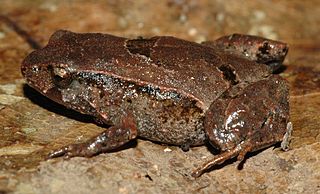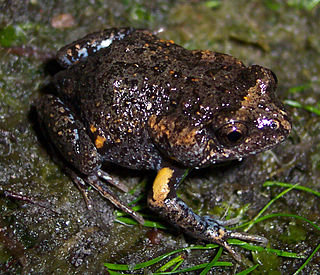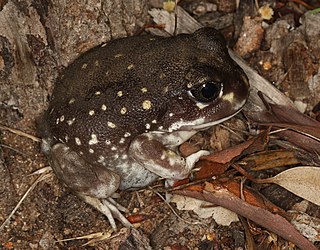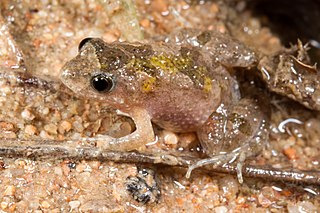
Corroboree frogs comprise two species of frog native to the Southern Tablelands of Australia. Both species are small, poisonous ground-dwelling frogs. The two species are the southern corroboree frog and the northern corroboree frog. They are unique among frogs in that they produce their own poison rather than obtain it from their food source as is the case in every other poisonous frog species.

The pouched frog, or hip pocket frog, is a small, terrestrial frog found in rainforests in mountain areas of south-eastern Queensland and northern New South Wales, Australia. It is one of two species within the genus Assa, the other being Assa wollumbin and is part of the family Myobatrachidae.

Crinia is a genus of frog, native to Australia, and part of the family Myobatrachidae. It consists of small frogs, which are distributed throughout most of Australia, excluding the central arid regions. Many of the species within this genus are non-distinguishable through physical characteristics, and can only be distinguished by their calls.

Geocrinia is a genus of frogs in the family Myobatrachidae. These frogs are endemic to Australia. Two species are known from southeastern Australia, while one is known from southeastern Western Australia.

Uperoleia is a genus of frogs in the family Myobatrachidae. They are native to northern and eastern Australia and southern lowlands of New Guinea. These are small squat frogs, more commonly known as "toadlets". They have glandular skin, often with a pair of raised glands behind each eye, or on the flanks.

Rheobatrachus, whose members are known as the gastric-brooding frogs or platypus frogs, is a genus of extinct ground-dwelling frogs native to Queensland in eastern Australia. The genus consisted of only two species, the southern and northern gastric-brooding frogs, both of which became extinct in the mid-1980s. The genus is unique because it contains the only two known frog species that incubated the prejuvenile stages of their offspring in the stomach of the mother.

Myobatrachidae, commonly known as Australian ground frogs or Australian water frogs, is a family of frogs found in Australia and New Guinea. Members of this family vary greatly in size, from species less than 1.5 cm (0.59 in) long, to the second-largest frog in Australia, the giant barred frog, at 12 cm (4.7 in) in length. The entire family is either terrestrial or aquatic frogs, with no arboreal species.

The tusked frog is a species of ground-dwelling frog native to eastern Australia from Eungella National Park, Queensland south to Ourimbah, New South Wales. It is the only species in the genus Adelotus - adelotus meaning "unseen" and brevis meaning "short".

The northern sandhill frog is a small, fossorial frog native to a small region of the Western Australian coast. It was formerly considered the sole species within the genus Arenophryne until the first decade of the 2000s, when a new species of frog called the southern sandhill frog was discovered about 100 kilometres from Geraldton, Western Australia in Kalbarri National Park and given the scientific name Arenophryne xiphorhyncha.

Amphibians of Australia are limited to members of the order Anura, commonly known as frogs. All Australian frogs are in the suborder Neobatrachia, also known as the modern frogs, which make up the largest proportion of extant frog species. About 230 of the 5,280 species of frog are native to Australia with 93% of them endemic. Compared with other continents, species diversity is low, and may be related to the climate of most of the Australian continent. There are two known invasive amphibians, the cane toad and the smooth newt.

Metacrinia is a genus of frog in the family Myobatrachidae. It is monotypic, being represented by the single species, Metacrinia nichollsi, commonly known as the Forest toadlet or Nicholls toadlet. It is endemic to Southwest Australia, occurring between Dunsborough and Albany.
Sand Hill, Sandhill, Sand Hills, or Sandhills may refer to:
Anstisia vitellina, commonly known as the orange-bellied frog, is a species of frog in the family Myobatrachidae. It is endemic to a 20 hectare area near Margaret River in Southwest Australia. It is vulnerable to extinction due to fire and the destruction of habitat caused by feral pigs.

Myobatrachus is a genus of frogs found in Western Australia. It is monotypic, being represented by the single species, Myobatrachus gouldii, also known as the turtle frog. It gets its name from the resemblance to a shell-less chelonian, which is a type of turtle. It is described to have an extremely small narrow head, short limbs, and a round body. They can get up to 45 millimetres (1.8 in) long. Anatomy studies of this species say that it has an incredibly large pectoral girdle for its size. Due to its unusual morphology, the features of this creature are thought to originate with old frog lineages from the early Tertiary or late Mesozoic eras.

The western spotted frog is a species of frog in the family Limnodynastidae. It is endemic to Western Australia. Its natural habitats are temperate forests, temperate shrubland, intermittent rivers, freshwater marshes, rocky areas, granite outcrops, arable land, pastureland, open excavations, and canals and ditches. It is threatened by habitat loss and salinity.

The desert froglet, chirping froglet, or sparrow froglet is a species of frog in the family Myobatrachidae, endemic to Australia. Desert froglets occur mainly in dry or moist savanna habitats, principally from the mid-western border of Northern Territory, south-east into western Queensland and New South Wales and the north-east corner of South Australia. They can also be found along the Queensland coast where it has been recorded between Townsville and Cooktown, and as far south as Hervey Bay.

The quacking frog, also known as the red-thighed froglet due to its legs tending to be bright red, is a species of frog from the Myobatrachidae family and is in a clad with five other species. The frog is well known for the sound it produces which resembles a quack. It has up to 11 notes and can change the notes in their call. It has larger testes compared to other frogs within the genus and has started to be used in experiments. This frog is found in southwest Australia. It is found in ponds and pools and other moisture filled areas. These frogs engage in polyandry and can result in multiple paternity of its offspring. Additionally, the tadpoles of this species can change the rate they metamorphosize depending on the conditions. The males tend to have larger arm girth and can adopt different mating strategies depending on size. The mating strategy is dependent on male density. The frogs also vary in terms of colour and texture of its skin. The tadpoles are generally golden with transparent tails.
The Amphibians of Western Australia are represented by two families of frogs. Of the 78 species found, most within the southwest, 38 are unique to the state. 15 of the 30 genera of Australian frogs occur; from arid regions and coastlines to permanent wetlands.
Arenophryne xiphorhyncha, the southern sandhill frog, is a fossorial anuran found in a limited range of far western Australia. The only congener to A. xiphorhynca is the northern sandhill frog, Arenophryne rotunda, which was considered the sole species within the genus Arenophryne until this species was discovered about 100 kilometres from Geraldton, Western Australia, in Kalbarri National Park.
Anstisia is a genus of frogs in the family Myobatrachidae. These frogs are endemic to southern Western Australia.















